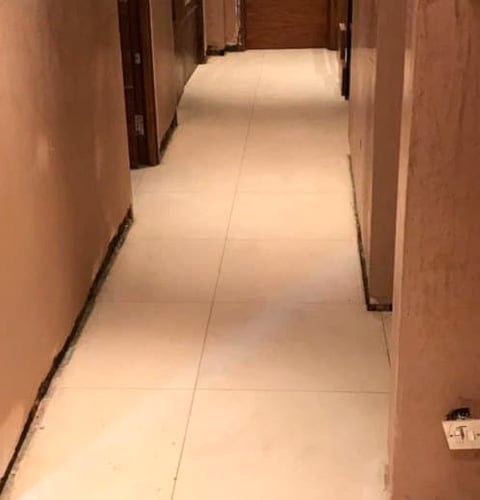Few structural problems are more worrying for homeowners than rising damp. Fixing it can be expensive, and leaving it alone results in damp patches, mould, wet rot, and severe structural damage to internal walls and external walls. Penetrating damp can also exacerbate these issues, leading to further complications.
But rising damp issues are often misdiagnosed, sometimes accidentally, sometimes by cowboys overcharging for a rising damp issue that may have a far simpler cause.
If you understand how rising damp occurs and how to spot it, you’re less likely to have wool pulled over your eyes by unscrupulous damp “experts”.
If you understand what causes rising damp and how to spot signs of rising damp, you’re less likely to have the wool pulled over your eyes by unscrupulous local rising damp specialists.
HOW DOES RISING DAMP OCCUR?
Bricks are porous, which allows them to “breathe”, releasing moisture during the day and absorbing it during the night.
This moisture breathing regulates the temperature and humidity in a building, making it ideal for our changeable climate in the UK.
Their sponge-like structure also allows the mortar to adhere tightly to the brick, locking them in a place far better than if they were a smooth, hard material.
But their greatest strength is also their weakness. If water is being absorbed at a faster rate than it can be released, the bricks will become wet and vulnerable to salt damage, which may lead to damp on internal walls and damp spreading inside the house.
Excess water can come from driving rain, leaky gutters, masonry cracks or ground cracks.
Rising damp begins when bricks suck up water from the ground (also known as capillary action), allowing rising damp on internal walls to build up, typically in basements or ground floor walls. You may notice a rising damp smell or other rising damp signs, such as damp patches and wet rot in these areas.
Stopping moisture from being sucked up into walls has been a challenge for builders for centuries. Treating rising damp problems involves stopping this capillary action, often by installing or repairing a damp proof course.
WHAT ARE THE CONSEQUENCES OF UNTREATED RISING DAMP?
If left untreated, rising damp can lead to severe consequences that are best avoided, including:
- Structural Damage: Rising damp can weaken the walls, floors, and other building materials, compromising the structural integrity of your property.
- Dry Rot: This wood-rotting fungus thrives in damp conditions and can spread rapidly, causing extensive damage.
- Wet Rot: Another type of fungal decay, wet rot, can cause significant damage to wooden structures.
- Pest Infestation: Damp conditions can attract pests such as woodworms, leading to further damage.
- Health Problems: Rising damp can contribute to respiratory issues and allergies due to mould and mildew growth.
- Reduced Property Value: The presence of rising damp can decrease the value of your property and increase maintenance costs.
Addressing rising damp promptly is essential to avoid these serious consequences and protect your investment.
WHAT IS A DAMP PROOF COURSE?
Since 1875, all new houses are required by law to have a damp proof course (DPC).
At first, a DPC was a layer of hard, non-porous stones such as slate or flint, acting as a barrier to stop groundwater from being soaked up into the bricks above.
Today’s damp proof courses are made from PVC plastic, which lasts longer, is more effective, and easier to install than the traditional stone method. In cases where PVC isn’t suitable, low absorption bricks or a physical damp proof membrane may be used.
While the law has required a DPC to be built into homes since 1875, actual enforcement of that law and general building standards were far less strict in the past.
Many period homes suffer from rising damp due to age, shoddy workmanship, or a complete lack of a DPC.
Improved building techniques mean rising damp is less common in modern homes, but it can still arise if the design is poor or groundwater levels were not considered.
If your building is suffering from rising damp, it’s a problem which won’t go away without either fixing or replacing the failed damp proof course.
IDENTIFYING AND TREATING RISING DAMP
If you suspect your building is suffering from rising damp, it’s important to identify rising damp accurately through a rising damp survey conducted by reputable experts. Consulting a professional damp surveyor is crucial for accurately diagnosing and treating a rising damp issue. Look out for rising damp signs, such as peeling paint, crumbling plaster, and a characteristic rising damp smell in affected areas.
Once diagnosed, treat rising damp promptly. Rising damp treatment typically involves repairing or installing a new damp proofing system to eliminate rising damp. This could mean fixing or replacing a failed damp proof course or implementing other moisture control methods, such as improving drainage around the property.
Without addressing the root cause, rising damp problems will not go away. It’s essential to seek professional advice from the qualified rising damp specialist at Environ Property Services to ensure you choose the most effective solution and safeguard your home against future damage.
Frequently Asked Questions
How can I identify rising dampness?
Look for a tide mark on walls near ground level, peeling paint, crumbling internal plaster, a musty smell, or salt deposits. Severe cases may damage floor joists or create damp patches.
What causes rising dampness?
Rising dampness occurs when water from the ground is drawn upward through very fine tubes in walls. A failed damp proof course, high external ground levels, or poor drainage often contribute.
Why hire a damp proofing specialist?
A damp proofing specialist diagnoses rising dampness and recommends solutions like repairing damp proof courses, adjusting external ground levels, or fixing cavity wall issues to protect your property.
Can rising dampness damage my home?
Yes, it can weaken walls, cause fungal decay in floor joists, and lead to salt contamination. Prompt action prevents long-term structural damage and protects property value.

